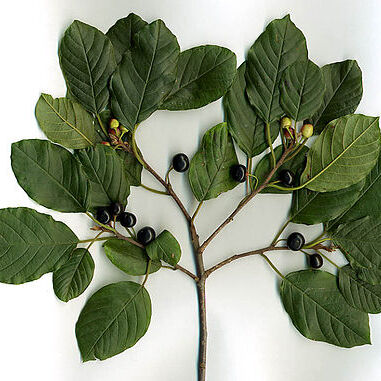Trees or shrubs, rarely woody vines, mostly unarmed, deciduous, the buds scaly or naked. Leaves alternate, rarely opposite, pinnately-veined, entire or toothed, mostly petiolate. Inflorescences umbellate cymes, sometimes reduced to a single flower, sessile or pedunculate. Flowers bisexual or polygamo-dioecious, small, perigynous; floral tube cupulate to campanulate; calyx lobes 4-5, ovate to deltoid, deciduous separately or with the circumscissile upper part of the floral tube after anthesis; petals 4-5, shorter than the calyx-lobes, ovate to obovate, concave, hooded or flat, often clawed, the margin entire or bibbed apically, inserted at the margin of the floral tube; stamens 4-5, functional or sterile and rudimentary in carpellate flowers, about as long or longer than the petals, inserted at the upper margin of the floral tube; nectariferous disc lining the wall of the floral tube, sometimes thickened near its margin; ovary superior, 2-3-carpellate, + 2-3-locular, the ovules 2-3, the style simple or 2-3-lobed, the stigma 2-3-lobed. Fruit a drupe, subglobose, dark red to black, containing 2-3 pyrenes; seeds 2-3, lenticular or wedge-shaped.
Shrubs or trees, erect or spreading, unarmed or armed with thorns; bud scales present, buds glabrate. Leaves deciduous or persistent, present at flowering, alternate or opposite to subopposite, sometimes fascicled on short shoots; blade not gland-dotted; pinnately veined, secondary veins arching, not parallel. Inflorescences axillary, within foliage, fascicles or cymes, or flowers solitary; peduncles and pedicels not fleshy in fruit. Pedicels present. Flowers usually unisexual, rarely some bisexual (plants polygamous); hypanthium campanulate to cupulate, 2–3 mm wide, usually not circumscissile, rarely so at or just proximal to sepal bases; sepals 4–5, spreading, yellowish, yellowish green, green, or greenish white to white, ovate-triangular, thin, not keeled or crested adaxially; petals 0 or 4[–5], yellowish to cream, hooded, spatulate, not clawed; nectary thin, lining hypanthium; stamens 4–5, (rudimentary in pistillate flowers); ovary superior, 2–4-locular; styles 2–4, connate proximally. Fruits drupes; stones 2–4, longitudinally dehiscent. Seeds obovoid or oblong-obovoid, not beaked, longitudinally furrowed. x = 12.
Shrubs, small trees or scramblers. Leaves alternate to opposite, petiolate, concolorous, penniveined; stipules free, caducous. Inflorescences comprising axillary or extra-axillary short, pedunculate cymes or diffuse foliose pseudoracemes; bracts persistent. Flowers bisexual or dioecious, 4-or 5-merous, greenish. Hypanthium cup-shaped. Sepals erect or spreading, caducous. Petals cucullate or longitudinally rolled around the filament, obscurely clawed, incurved or erect, sometimes absent. Stamens subequal to the petals, incurved. Disc thin, lining the hypanthium, smooth, glabrous. Ovary free, superior; carpels 1–3 (or 4); style deeply branched. Fruit a black (red when young) fleshy drupe with free pyrenes; torus basal.
Trees or shrubs (or scandent shrubs). Leaves alternate (or opposite but not in East Africa), petiolate. Stipules present, small, free, usually soon deciduous. Flowers usually in axillary cymes or these reduced to fascicles or solitary flowers, or rarely in more elaborate bracteate or non-bracteate panicles or thyrses, 5-or 4-merous, usually perfect but in some species dioecious (? not in East Africa), perigynous. Petals present or absent. Disk thin, lining the cup. Ovary 3-celled or reportedly rarely 4-celled (or 2-celled but not in East Africa). Style usually 3-partite about half the length. Fruit a drupe with 3 (or 2 but not in East Africa) or rarely 4 free 1-seeded stones.
Shrubs or small trees, mainly deciduous, often spiny; indumentum of simple hairs or 0. Winter buds with scales. Lvs with small, mostly caducous stipules, alternate or opposite, small to large, often with basal pair of veins more prominent. Fls small, in axillary racemes, cymose umbels or fascicles, usually unisexual (plants dioecious or monoecious), 4-(5)-merous. Calyx lobes triangular. Petals often folded to form a hood, shortly clawed, sometimes 0. Stamens ± included. Staminodes present in ♀ fls. Ovary 2-4-celled, free from disc; styles 2-4; stigmas small, simple. Fr. a drupe with 2-4, nutlet-like pyrenes. Seed furrowed; germination epigeal.
Fls 4–5-merous, perfect or unisexual, the staminate with vestigial pistil, the pistillate with shorter or smaller stamens; pet lacking (in one sp.) or present, small, often obcordate with the sides folded about the stamen; ovary 2–4-locular; fr a drupe with 2–4 1-seeded stones; shrubs or trees with alternate or opposite, pinnately veined, usually toothed lvs and green or greenish-white fls solitary or umbellate in the axils of a few of the lower lvs of the current season. 100, widespread.
Leaves alternate or opposite or fasciculate, petiolate; lamina penninerved, margin often toothed.
Ovary superior, 2–4-locular; ovules 1 per loculus; style simple or 2–3(4)-fid.
Inflorescence an axillary fascicle (in our area), less often flowers solitary.
Fruit obovoid, drupaceous with a fleshy or somewhat woody endocarp.
Petals 4–5 or absent, cucullate or flat.
Disk thin, lining the receptacle.
Stipules small, soon deciduous.
Receptacle urceolate or flat.
Flowers usually bisexual.
Small trees or shrubs.
Sepals 4–5, valvate.
Stamens 4–5.

